Abstract
α-Cyclopropyl-α-[p-methoxyphenyl]-5-pyrimidine methyl alcohol (ancymidol) is an inhibitor of ent-kaur-16-ene oxidation in microsomal preparations from the liquid endosperm of immature Marah macrocarpus seeds. The Ki for this inhibitor is about 2 × 10−9 m. Ancymidol also blocks ent-kaur-16-en-19-ol and ent-kaur-16-en-19-al oxidation by the same preparations with a similar efficiency, but does not significantly inhibit ent-kaur-16-en-19-oic acid oxidation. Ancymidol appears to be specific for this series of oxidations in higher plant tissues. It does not inhibit the oxidation of kaurene nor kaurenoic acid in rat liver microsomes and has no significant effect on the oxidation of cinnamic acid in microsomal preparations from Sorghum bicolor seedlings. Ancymidol also does not inhibit kaurene oxidation in vitro nor in vivo in cultures of the fungus Fusarium moniliforme. The presence of ancymidol did not significantly alter the activities of NADPH-cytochrome c reductase, NADH-cytochrome c reductase, or NADH-cytochrome b5 reductase. The addition of ancymidol to suspensions of oxidized M. macrocarpus endosperm led to a difference spectrum with an absorption maximum at 427 nm and a minimum at 410 nm.
Full text
PDF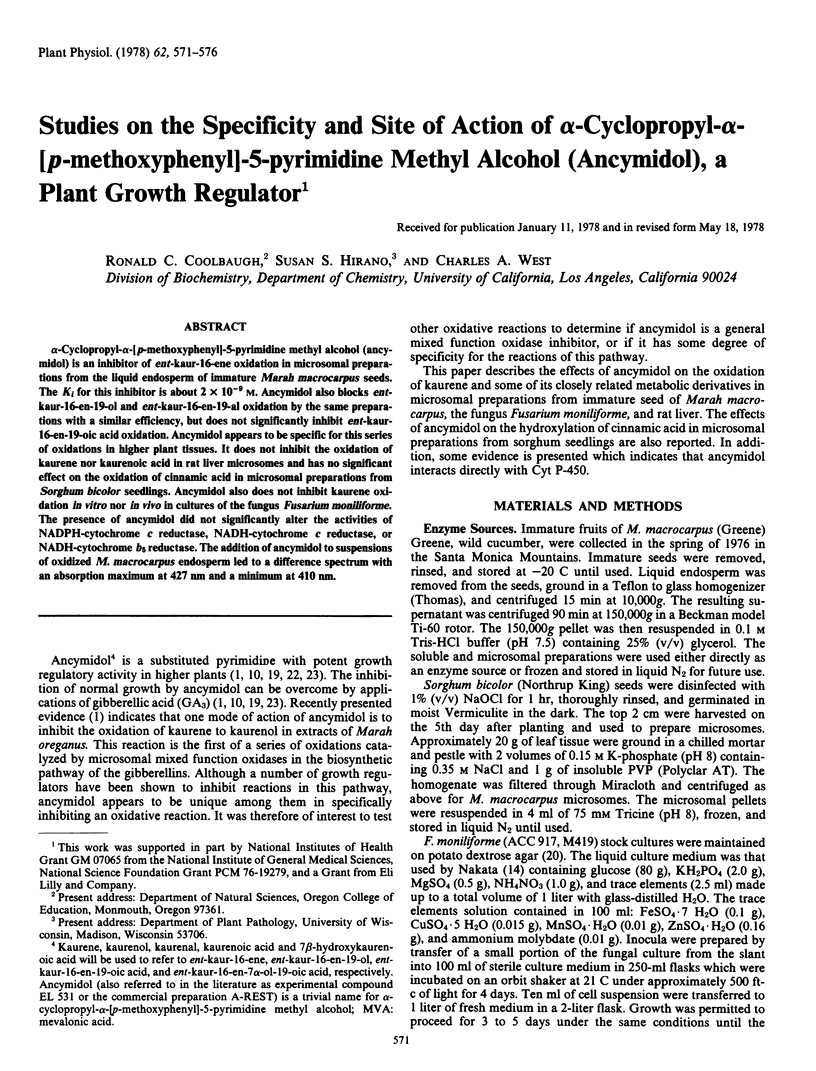
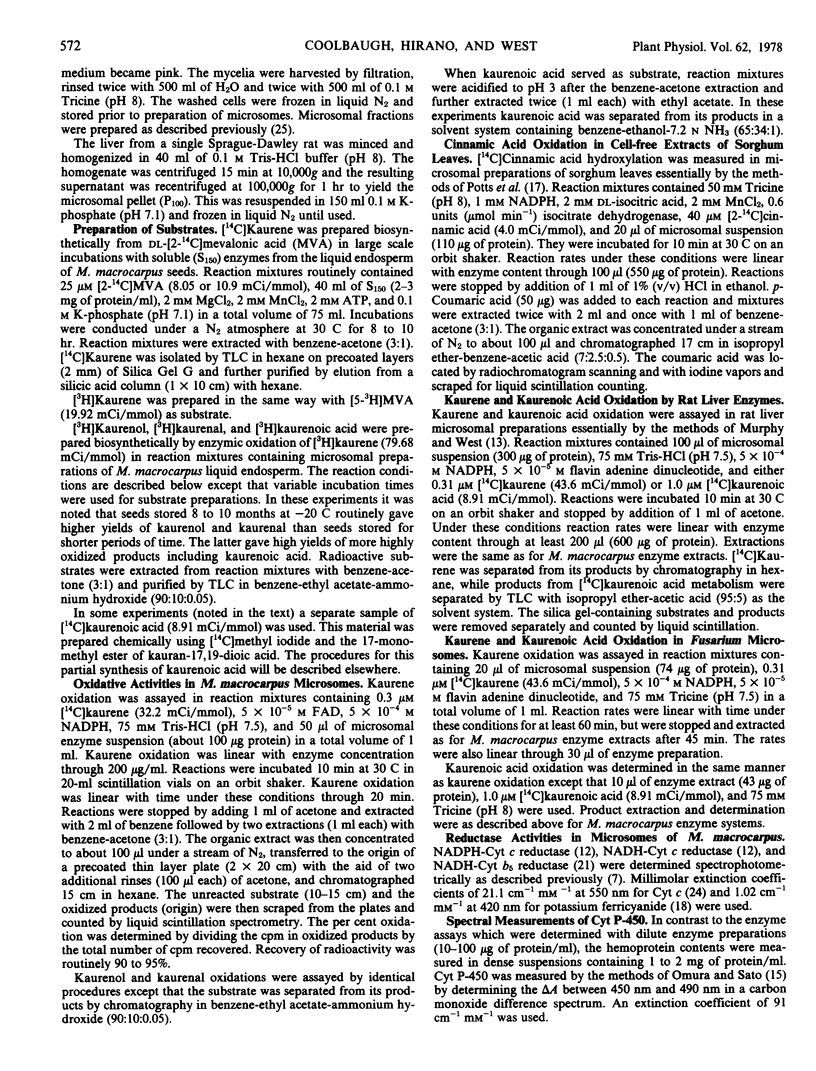

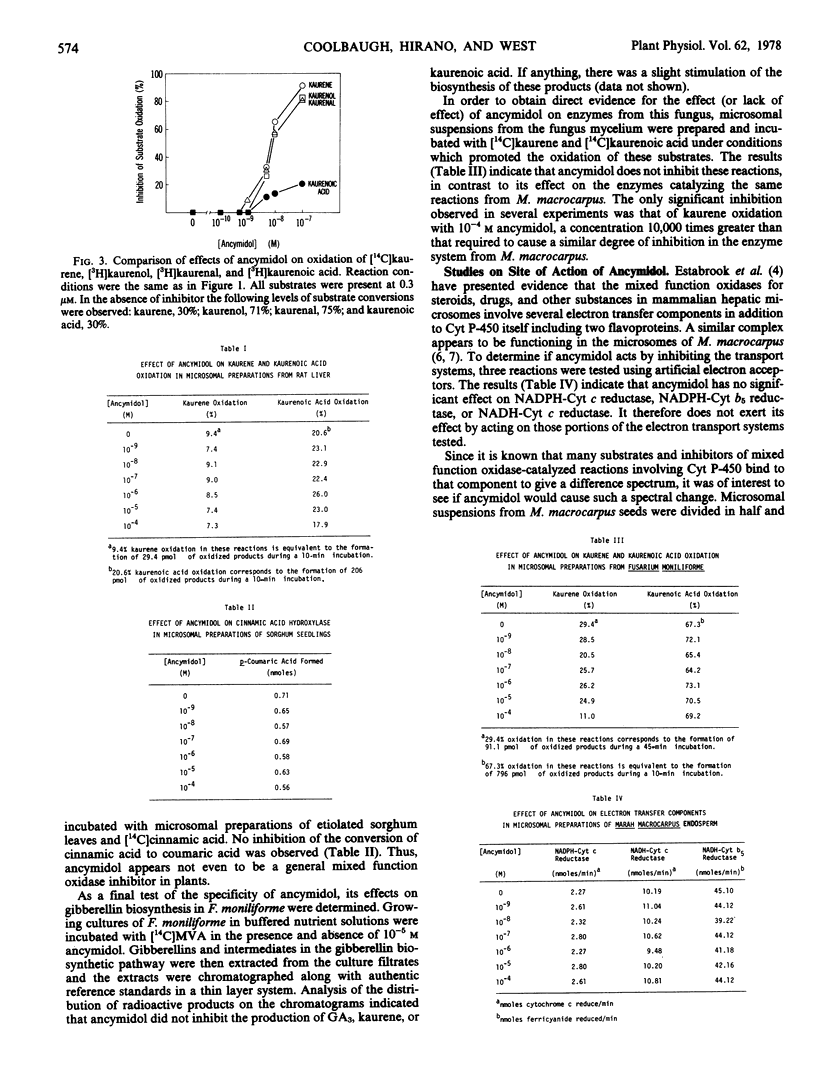
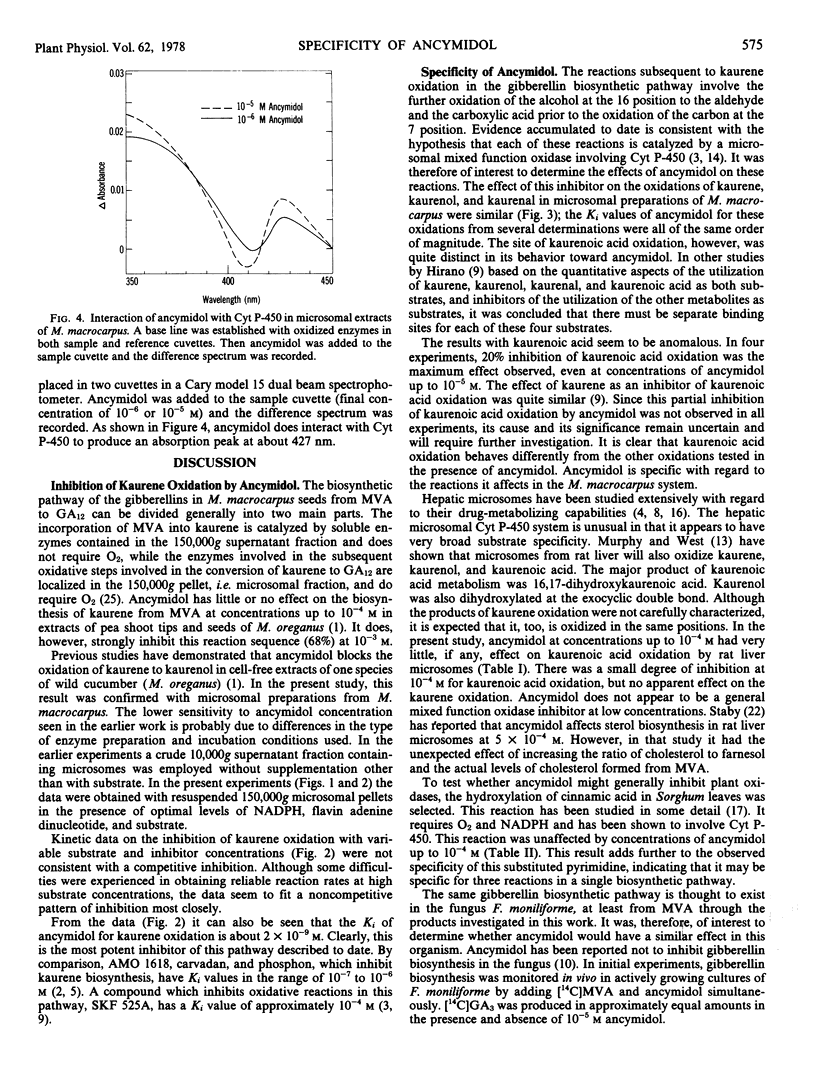
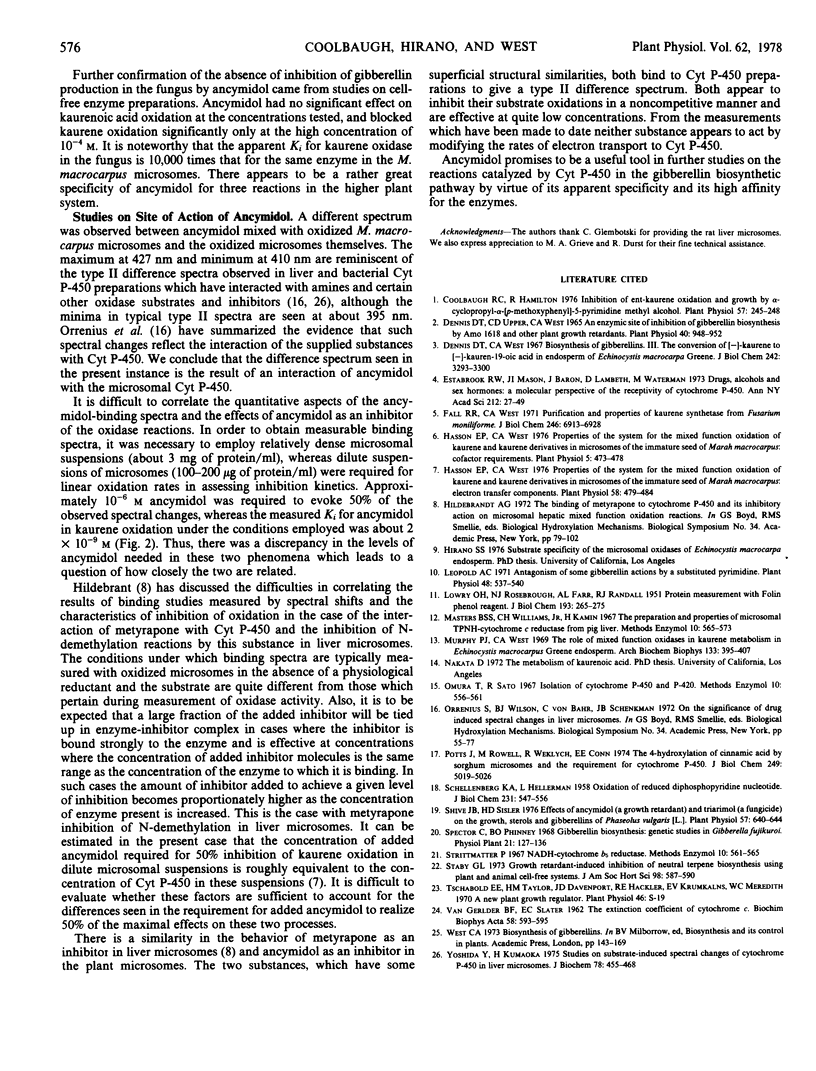
Selected References
These references are in PubMed. This may not be the complete list of references from this article.
- Coolbaugh R. C., Hamilton R. Inhibition of ent-Kaurene Oxidation and Growth by alpha-Cyclopropyl-alpha-(p-methoxyphenyl)-5-pyrimidine Methyl Alcohol. Plant Physiol. 1976 Feb;57(2):245–248. doi: 10.1104/pp.57.2.245. [DOI] [PMC free article] [PubMed] [Google Scholar]
- Dennis D. T., Upper C. D., West C. A. An enzymic site of inhibition of gibberellin biosynthesis by Amo 1618 and other plant growth retardants. Plant Physiol. 1965 Sep;40(5):948–952. doi: 10.1104/pp.40.5.948. [DOI] [PMC free article] [PubMed] [Google Scholar]
- Dennis D. T., West C. A. Biosynthesis of gibberellins. 3. The conversion of (-)-kaurene to (-)-kauren-19-oic acid in endosperm of Echinocystis macrocarpa Greene. J Biol Chem. 1967 Jul 25;242(14):3293–3300. [PubMed] [Google Scholar]
- Estabrook R. W., Mason J. I., Baron J., Lambeth D., Waterman M. Drugs, alcohol and sex hormones: a molecular perspective of the receptivity of cytochrome P-450. Ann N Y Acad Sci. 1973;212:27–49. doi: 10.1111/j.1749-6632.1973.tb47584.x. [DOI] [PubMed] [Google Scholar]
- Fall R. R., West C. A. Purification and properties of kaurene synthetase from Fusarium moniliforme. J Biol Chem. 1971 Nov 25;246(22):6913–6928. [PubMed] [Google Scholar]
- Hasson E. P., West C. A. Properties of the System for the Mixed Function Oxidation of Kaurene and Kaurene Derivatives in Microsomes of the Immature Seed of Marah macrocarpus: Cofactor Requirements. Plant Physiol. 1976 Oct;58(4):473–478. doi: 10.1104/pp.58.4.473. [DOI] [PMC free article] [PubMed] [Google Scholar]
- Hasson E. P., West C. A. Properties of the System for the Mixed Function Oxidation of Kaurene and Kaurene Derivatives in Microsomes of the Immature Seed of Marah macrocarpus: Electron Transfer Components. Plant Physiol. 1976 Oct;58(4):479–484. doi: 10.1104/pp.58.4.479. [DOI] [PMC free article] [PubMed] [Google Scholar]
- Hildebrandt A. G. The binding of metyrapone to cytochrome P-450 and its inhibitory action on microsomal hepatic mixed function oxidation reactions. Biochem Soc Symp. 1972;34:79–102. [PubMed] [Google Scholar]
- LOWRY O. H., ROSEBROUGH N. J., FARR A. L., RANDALL R. J. Protein measurement with the Folin phenol reagent. J Biol Chem. 1951 Nov;193(1):265–275. [PubMed] [Google Scholar]
- Leopold A. C. Antagonism of some gibberellin actions by a substituted pyrimidine. Plant Physiol. 1971 Nov;48(5):537–540. doi: 10.1104/pp.48.5.537. [DOI] [PMC free article] [PubMed] [Google Scholar]
- Murphy P. J., West C. A. The role of mixed function oxidases in kaurene metabolism in Echinocystis macrocarpa Greene endosperm. Arch Biochem Biophys. 1969 Sep;133(2):395–407. doi: 10.1016/0003-9861(69)90468-8. [DOI] [PubMed] [Google Scholar]
- Orrenius S., Wilson B. J., von Bahr C., Schenkman J. B. On the significance of drug-induced spectral changes in liver microsomes. Biochem Soc Symp. 1972;34:55–77. [PubMed] [Google Scholar]
- Potts J. R., Weklych R., Conn E. E., Rowell J. The 4-hydroxylation of cinnamic acid by sorghum microsomes and the requirement for cytochrome P-450. J Biol Chem. 1974 Aug 25;249(16):5019–5026. [PubMed] [Google Scholar]
- SCHELLENBERG K. A., HELLERMAN L. Oxidation of reduced diphosphopyridine nucleotide. J Biol Chem. 1958 Mar;231(1):547–556. [PubMed] [Google Scholar]
- Shive J. B., Sisler H. D. Effects of Ancymidol (a Growth Retardant) and Triarimol (a Fungicide) on the Growth, Sterols, and Gibberellins of Phaseolus vulgaris (L.). Plant Physiol. 1976 Apr;57(4):640–644. doi: 10.1104/pp.57.4.640. [DOI] [PMC free article] [PubMed] [Google Scholar]
- van GELDER B., SLATER E. C. The extinction coefficient of cytochrome c. Biochim Biophys Acta. 1962 Apr 23;58:593–595. doi: 10.1016/0006-3002(62)90073-2. [DOI] [PubMed] [Google Scholar]


